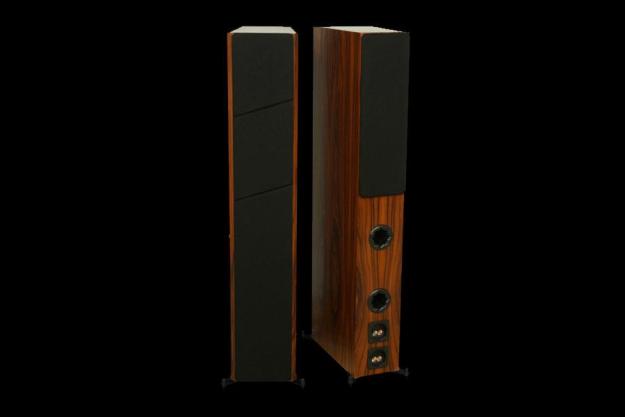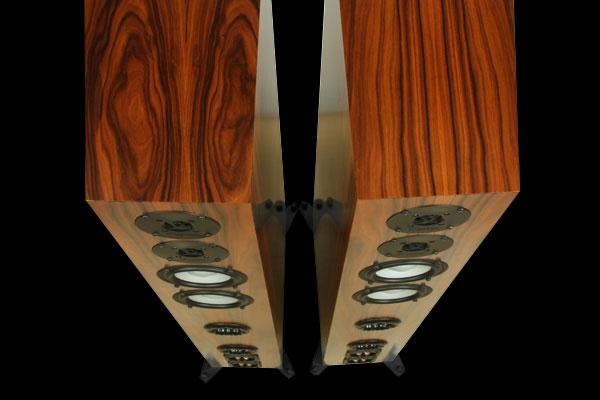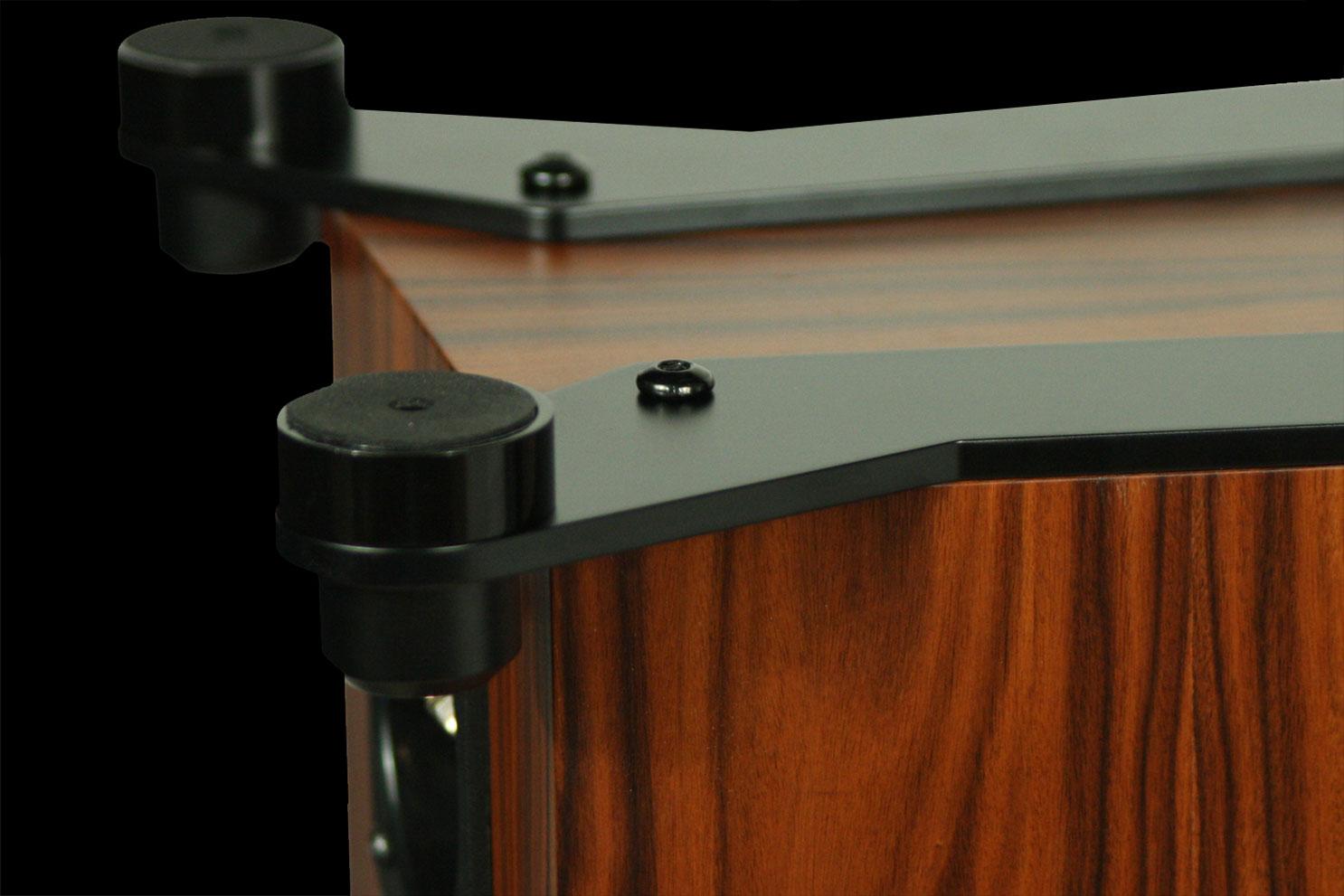
“Our experience with Axiom’s LFR-1100 speakers and ADA-1500-4 amplifier was one of brilliance, revelation, and total musical immersion…”
- Massive center image and sweet spot
- Lucid clarity
- Fantastic balance
- Near-live detail and definition
- Powerful, punctuated bass
- Omni-directional sound can limit stereo movement
- Veneer lacks wow-factor
One of the first rules you learn about setting up studio monitors is to keep them away from large boundaries like, you know, walls. It’s Acoustics 101. But bipolar speakers don’t play that way. They turn the “boundary interference theory” on its head by incorporating boundaries into the sound, aiming rear-firing drivers directly at them. After all, we’ve all got walls, why not use them? Trouble is, not all bipolar speakers are created equal. You can just start shooting sound around the room all willy-nilly; that’s the stuff audiophile nightmares are made of.
Axiom has recently taken the bipolar design concept to a new level with its colossal flagship speakers, the LFR-1100s. Touted as “omni-directional” speakers, each of these 11-driver monoliths employs front and rear-firing drivers under the strong command of a secret weapon in the form of a heavy-duty 4 channel DSP (DSP 1100). A mere $3760 gets all 22 drivers, the DSP, and a whole ‘lotta sound. But for this review, we also paired the speakers with Axiom’s ADA-1500-4, a $2900, class-D monster with a transformer the size of a roll of duct tape and enough 4-channel power to melt your faces.
Let’s be honest, you already know by now that this system sounds good. But how good is good, at this price? And what does omni-directional sound mean to your bi-directional ears? Read on to learn more.
Out of the box
Pulling the 1100s from their cardboard coffins revealed thick towers cut at a slight angle at the rear, with Boston Cherry veneers. Along the front and back face of each tower were magnetically attached grilles, sliced diagonally into segments. Removing the front screens of one of the towers, we were faced with a long trail of alabaster drivers, culminating with a gleaming pair of titanium tweeters at the top, and a “Vortex” port at the base. The backside of each tower housed four more drivers at the top, with mirrored sets of tweeters and midrange drivers, as well as two more “Vortex” ports, and a dual set of 5-way binding posts in shiny gold plating.

The DSP 1100 felt more like a full-on amplifier than a processor as we pulled it from its box, weighing around 25 lbs. The slits at its top gave us a peak at heavy gauge wires and circuit boards, and a massive power transformer. The ADA-1500-4 amplifier was of a similar design, cased in matte black metal, with no distinguishing features on the face save a single blue LED. The two units stacked together were heavy enough to give us pause as we hoisted them to the equipment rack in our test room.
Features and design
Like most full-sized stereo towers, the 1100s cut a striking figure when placed in our testing room, especially topless, flashing their throng of gleaming drivers. The angled design of the cabinets designates the speakers as left and right channels, providing a quick guide for initial setup. Axiom calls the cabinets “Anti-standing-wave”, designed to prevent unwanted resonance or tonal coloration, and a good knock on the side produced a dense, dead thump. The “Vortex” ports are shaped to enhance bass while minimizing port noise, or, chuffing.
The DSP 1100 felt more like a full-on amplifier than a processor as we pulled it from its box, weighing around 25 lbs.
The front driver arsenal includes a triple dip of 6.5-inch woofers placed below four 5.25-inch midrange drivers, all of which are constructed from high-grade aluminum. Above the aluminum cones are dual titanium tweeters, secured in black metallic screens. As mentioned above, the backside reveals a mirror image from the top down, ending at the second midrange driver, and capping the total at eleven individual drivers. That’s right, these ones go to eleven. The speakers accept a max power of 400 watts, and are rated from a listening window of 32Hz-20KHz. The crossover points are set at 160Hz for the mids and 2.3KHz for the tweeters, leaving a lot of space for those titanium capsules to sing.
The LFR-DSP is the captain of the omni-directional ship, providing a delicate balance between the front and rear-firing drivers. The black box hides a special formula of DSP, as well as some serious electrical gear and premium quality 24-bit, Sigma-Delta ADCs and DACs @ 96kHz sampling rate. Since the magic is done in the digital realm, the entire binary signal path takes place in the LFR-DSP, putting it on the front lines of the sound transference from real-life electrical signals, to ones and zeros, and back again. The DSP also splits the stereo source into the four channels necessary to feed the sound to your chosen amplifier, and out to the speakers.
Speaking of amplifiers, the ADA-1500 amplifier is a wise choice, if you’re looking. The “1500” represents the amp’s total wattage, and it’s plenty powerful enough for the dual-faced towers. Perhaps even more encouraging is the stress of “suppleness” at Axiom’s website, seeming to place a premium on the quality of the power, not just the quantity. The amplifier provides four inputs in both RCA and XLR formats, and four binding post outputs. Under the hood are high grade components, including a large toroidal transformer, large filter capacitors, and a class-D module, all secured in a steel chassis.
Setup
Associated equipment for this review included an Oppo BDP-95 Universal Audiophile 3D Blu-ray player for source material, and an Anthem 225 Integrated amplifier acting as a pre-amp. The LFR-DSP case split the stereo source into four channels, feeding the ADA-1500-4 amplifier. We sent sound from the ADA to the speakers via heavy gauge, pro-quality speaker wire terminated with banana plugs.
Performance
The first thing we noticed about the 1100’s, before their brilliant accuracy and fiercely disciplined hurricane-force, was the astonishing width of the sound stage and breadth of the center image. The tandem team of front and rear-firing drivers used the backdrop of our test room to create a perfect synthesis between the speaker faces, bringing a whole new meaning to the phrase “wall of sound”. In opposition to standard stereo towers that often have a narrow sweet spot, the “omni-directional” 1100’s allowed us to move almost anywhere in the room and hear a balanced stereo sound. The effect was actually kind of weird at first, like those old portraits that stare at you no matter where you sit in the room.

When we planted in front of the towers, the center image was massive, seeming to engulf us in rushing waves of sound, as if reaching towards us. The wide field offered tangibly present vocals, as if a giant version of the artist in front of us had been teleported from the sound booth and zoomed in. Sounds mixed to the left or right were pushed far to the perimeter, with instruments and reverb pulses creeping from the sides into the deep center canvas, swirling gracefully across the plane.
The 1100’s stunning frequency balance could be felt throughout the spectrum, with smooth, effortless transitions across instrumental combinations from artists as varied as Jaco Pastorius to David Bowie. Midrange instruments were vibrant and remarkably translucent, while high treble instruments like triangles sparkled in lingering bursts. Listening to the most carefully produced tracks in our catalog, snare and percussion hits were so detailed and varied, we felt as if we could pluck each one from the groove and assign them names.
The 1100’s are also remarkable for their extremely fast transient response, perhaps most impressive in the bass. There we were treated to powerful, quaking hits that could also turn on a dime, with extremely fast entrances and exits. One prime example came from Radiohead’s “House of Cards,” which entered with a pounding downbeat that echoed with the force of a heavy-duty construction drill slamming against asphalt. The groove had a staunch, guttural force that was also focused and restrained.
The wide field offered tangibly present vocals, as if a giant version of the artist in front of us had been teleported from the sound booth and zoomed in.
Moving through our test tracks we heard sinuous electric guitar tones and velvety strokes across acoustic strings, as if from inside the sound hole. Brass was clean and flashy, and reedy instruments were richly exposed. There were instances in which we actually wrote in our notes “this is the best it’s ever sounded,” including the Black Keys’ “Gold On The Ceiling,” which may as well have been live (aside from the perfect vocals).
The only complaint we might offer is that on some tracks, the speakers’ huge center image allowed for less stereo movement for those instruments panned closer in. Other than that, we really had nothing bad to say about the 1100’s. They’re that good.
Conclusion
Our experience with Axiom’s LFR-1100 speakers and ADA-1500-4 amplifier was one of brilliance, revelation, and total musical immersion, on par with some of the best listening sessions we’ve ever experienced. We tested this system from every angle – literally and metaphorically – and we had a near impossible time exposing a flaw.
On top of that, the LFR-1100s’ massive soundstage and vibrant power also make them the perfect system for large gatherings of folks who actually care about the sound – no more fighting over that sweet spot. (Audiophile party anyone?) If you’re looking to step into a real home hi-fi system, we think purchasing the Axiom LFR-1100 and ADA-1500-4 is an investment you will never regret.
Highs
- Massive center image and sweet spot
- Lucid clarity
- Fantastic balance
- Near-live detail and definition
- Powerful, punctuated bass
Lows
- Omni-directional sound can limit stereo movement
- Veneer lacks wow-factor





